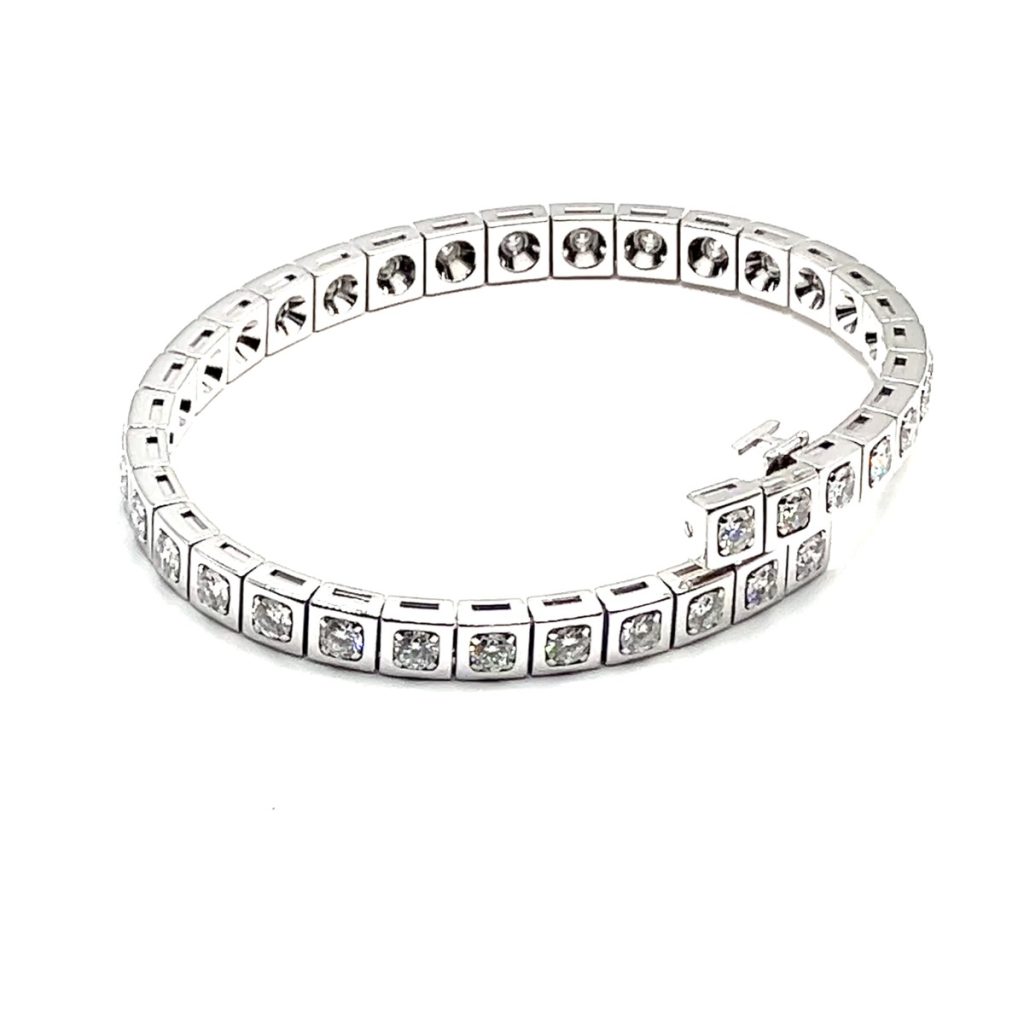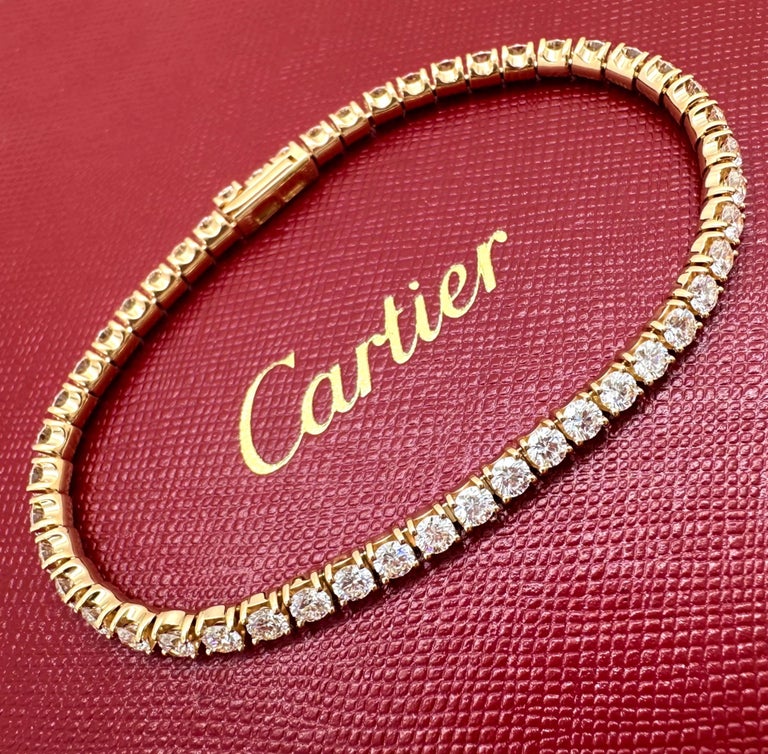The Story of the Tennis Bracelet
A Moment That Sparked a Movement
It happened during a high-stakes U.S. Open match in the late 1970s. The crowd hushed, the world watched, and tennis champion Chris Evert paused mid-rally. Her opponent waited. The cameras zoomed in. Something had slipped from her wrist — a delicate line of diamonds, now scattered across the court.
The match stopped. Evert, elegant even in concentration, calmly asked the umpire for time to find her lost diamonds. When play resumed, the world had already fallen in love — not only with her composure, but with the bracelet itself.
That televised moment transformed a piece of fine jewelry into legend. What had once been known quietly as a “diamond line bracelet” would forever be called the tennis bracelet — a piece as graceful and composed as the athlete who refused to play without it.

Before the Spotlight: The Origins of a Diamond Classic
Long before television lights and headlines, the tennis bracelet began life in the ateliers of early 20th-century jewelers. The Art Deco era celebrated symmetry and clean geometry, and jewelers began creating “line bracelets” — slender rivers of diamonds set one by one in platinum and white gold.
They were refined, effortless, and strikingly modern. A single continuous line of gems represented eternity, purity, and strength. These bracelets adorned flappers, debutantes, and Hollywood starlets alike — women who embraced independence without sacrificing glamour.
By the 1950s, the line bracelet had become a staple in luxury jewelry boxes. It wasn’t yet called a “tennis bracelet,” but its reputation was sealed: timeless, versatile, and eternally elegant.
The Chris Evert Era: When Diamonds Met Determination
Chris Evert’s match in 1978 did more than coin a name — it reframed what diamonds could mean. Until then, diamonds were largely seen as evening adornments, reserved for black-tie events and gala nights. Evert wore hers on the court.
Her diamond bracelet wasn’t for show; it was a part of her — a symbol of focus, confidence, and grace under pressure. Viewers were captivated. Jewelers took note. Within months, diamond houses began marketing “tennis bracelets” designed with stronger clasps, flexible mounts, and modern lines.
A piece that had once whispered elegance now shouted independence. Women around the world began wearing diamond bracelets not just for occasions, but every day. Luxury had become wearable — and that changed everything.
The Anatomy of a Legend
The enduring appeal of the tennis bracelet lies in its precision. Each stone, each link, each clasp is a study in perfect balance.
-
Matched Diamonds: Every gem is calibrated to mirror the next in size, cut, and brilliance, forming a seamless ribbon of light.
-
Fluid Movement: Its articulated links allow the bracelet to bend, flex, and rest naturally against the wrist.
-
Safety Meets Sophistication: Modern designs feature secure box clasps with double safety latches — a quiet nod to Evert’s famous mishap.
-
Metal Mastery: Platinum and 18k gold remain timeless, though rose and yellow gold add modern warmth.
A true diamond tennis bracelet feels alive — it moves with you, catching light like liquid fire.
The Craft Behind the Sparkle
Creating a tennis bracelet is an art form in itself. Every millimeter matters. Jewelers spend hours matching stones by hand, ensuring no single diamond steals the show. The goal is harmony — not flash.
Top houses such as Cartier, Tiffany & Co., and Harry Winston achieve this harmony through meticulous craftsmanship. Each bracelet must drape flawlessly — not too stiff, not too loose.
Inside luxury workshops, gem setters work beneath microscopes, placing each diamond with tweezers so fine they resemble surgical tools. The result? A piece that glows with invisible perfection.

The 4Cs: The Science of Beauty
Every tennis bracelet owes its allure to the 4Cs of diamonds — cut, color, clarity, and carat weight.
-
Cut: The foundation of brilliance. A perfectly cut stone returns light like a prism, igniti
ng the entire bracelet. -
Color: For most bracelets, G–H grades provide ideal brightness; D–F grades deliver icy perfection.
-
Clarity: VS and SI stones strike the best balance between purity and value, offering eye-clean sparkle.
-
Carat Weight: The sum defines the bracelet’s statement — from subtle 2-carat daily wear to dazzling 10-carat showpieces.

Old World vs. New World Diamonds
A century ago, only mined diamonds adorned the wrists of the elite. Today, lab-grown diamonds have introduced a new chapter in fine jewelry.
Chemically and visually identical to mined stones, they offer a sustainable, accessible option. Innovators such as De Beers and Chopard have embraced both worlds — traditional natural diamonds for heritage collections and lab-grown for contemporary lines.
Ethical sourcing, transparency, and environmental consciousness have become part of luxury’s DNA.
A Bracelet for Every Generation
Unlike trends that rise and fade, the tennis bracelet adapts. It has evolved through decades — sometimes slim and understated, sometimes bold and architectural.
Today’s designs range from minimalist to dramatic. Some mix diamonds with colored gems like sapphires and emeralds. Others feature fancy cuts — emerald, pear, or princess — for modern flair. Yet the essence remains: simplicity in motion, brilliance without effort.
A tennis bracelet is not just jewelry; it’s the punctuation mark of a life well-lived.
How to Wear It: The Modern Woman’s Signature
The beauty of the tennis bracelet lies in its versatility. It doesn’t scream; it whispers — and that whisper can be worn anywhere.
-
Layer two or three bracelets for depth and texture.
-
Mix metals — white gold with rose gold, or platinum with yellow — for contrast.
-
Pair it with a luxury watch or a statement cuff.
-
Wear it solo for that minimalist, effortless glow.
Whether you’re attending a Hamptons dinner or running between meetings in Manhattan, the tennis bracelet never feels out of place.
The Great Houses of Brilliance
The tennis bracelet has inspired every major jewelry maison to interpret it through their own lens of craftsmanship and creativity.
Cartier
A symbol of enduring Parisian grace. Cartier’s designs favor clean geometry and timeless luxury, meant to last lifetimes.
Tiffany & Co.
The world’s most iconic American jeweler has elevated the tennis bracelet to an art form, marrying precision with purity.
Harry Winston
Revered as The King of Diamonds, Harry Winston’s line bracelets are the epitome of fire and brilliance.
Van Cleef & Arpels
Soft articulation, fluid movement, and romantic French craftsmanship define this maison’s approach.
Bulgari
Roman boldness meets architectural beauty. Bulgari’s versions bring energy and confidence to the classic form.
Graff
For those who seek perfection. Graff’s bracelets use extraordinary stones that create light from within.
Chopard
Swiss precision meets ethical sourcing — each piece radiates refinement and conscience.
De Beers
Pioneers of diamond excellence, De Beers bracelets capture the natural brilliance of the earth itself.
Boucheron
Playful French innovation gives Boucheron’s bracelets their signature movement and charm.
David Yurman
Modern, approachable, and distinctly American — perfect for everyday luxury.

Where to Buy Tennis Bracelets
Finding your perfect tennis bracelet is as personal as the piece itself.
-
Flagship Boutiques: Visit Cartier, Tiffany & Co., or Harry Winston for personalized service and exclusive collections.
-
Luxury Retailers: Saks Fifth Avenue, Bergdorf Goodman, and Neiman Marcus showcase premier selections.
-
Online Jewelers: Trusted platforms like Blue Nile, James Allen, and Brilliant Earth offer certified stones and insured delivery.
-
Estate Collections: Vintage lovers can explore 1stDibs and Christie’s Jewels for historic pieces with soul.
Each option offers something unique — whether you seek the sparkle of a new creation or the poetry of a vintage treasure.

Caring for a Lifetime of Brilliance
The tennis bracelet is meant to be worn, but cared for like an heirloom.
Clean gently with mild soap and warm water. Avoid harsh chemicals and ultrasonic cleaners unless recommended. Store flat in a soft pouch, and check prongs and clasps twice a year with a professional jeweler.
With care, your tennis bracelet will gleam as brilliantly in thirty years as it does today.
Luxury with Conscience
Today’s most discerning collectors look beyond sparkle — they look for purpose.
Brands such as Chopard and De Beers lead the ethical jewelry movement, ensuring that every gem is responsibly sourced. Meanwhile, Brilliant Earth has built a global reputation for transparency, offering both lab-grown and conflict-free diamonds.
Owning a tennis bracelet today means owning a story of craftsmanship, sustainability, and enduring beauty.
The Bracelet That Changed How We See Luxury
When Chris Evert bent down to retrieve her lost bracelet, she unknowingly changed fashion history. She proved that diamonds weren’t just for the velvet box — they could live on the wrist of a champion, move through daily life, and still carry the power of timeless elegance.
The tennis bracelet remains that rare balance between simplicity and strength. It’s not just about sparkle — it’s about confidence, grace, and the quiet luxury that endures long after the applause fades.
Whether you buy yours from Cartier, Graff, or Blue Nile, a tennis bracelet isn’t just jewelry. It’s a story — one of brilliance, movement, and a life lived in perfect rhythm.
New York Times Article on the Tennis Bracelet
Receive Social Life Magazine in the Mail, Subscribe Today!…Click Here!




